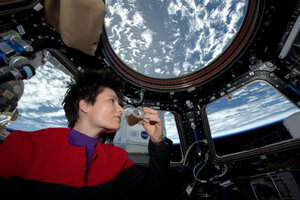I'll take my latte Zero-G. Science lessons from coffee in space
As part of her mission aboard the International Space Station, Italian astronaut Samantha Cristoforetti makes outer space espresso — and shares the experience with everyone on Earth.

In this photo posted on Twitter, Sunday, May 3, 2015, and provided by NASA, Italian astronaut Samantha Cristoforetti sips espresso from a cup designed for use in zero-gravity, on the International Space Station. Cristoforetti, the first Italian woman in space, fired up the first espresso machine in space, which uses small capsules, or pods, of espresso coffee.
NASA/AP Photo/File
It’s official: You don’t need to be on Earth to get a good cup of coffee.
Over the weekend, Italian astronaut Samantha Cristoforetti sipped from a cup of the first ever espresso brewed on the International Space Station (ISS). The coffee-making experiment was part of a study on fluid physics assigned to her during her nearly six-month stay in space — a mission designed “to inspire the next generation of engineers and scientists” as she shares her experiences with the public via social media, according to the European Space Agency’s (ESA) website.
“Fresh espresso in the new Zero-G cup!” Ms. Cristoforetti posted on Twitter. “To boldly brew…”
Since starting her stay on the ISS in November, Cristoforetti, the first Italian woman to embark on a long-term space assignment, has kept a daily log of photos, videos, and insights about life in orbit. Her posts, along with those of the five other astronauts aboard the station, provide a visual account of their experiments and activities, many of which are meant to promote science, fitness, and nutrition to children here on Earth as part of the Futura mission.
Cristoforetti’s involvement in educational activities has included taking questions from students about topics such as space technology and alternative food sources that are key to sustaining astronauts in space.
The espresso experiment, however, was as much for science in general as it was for education.
“Until Sunday, we didn’t know exactly how hot fluids under high pressure reacted” in the low-gravity environment of the ISS, Roberto Battiston, president of the Italian space agency ASI, told The New York Times. “Now we do.”
The espresso machine, called the ISSpresso, was developed by Italian engineering and software firm Argotec in collaboration with ASI and coffee company Lavazza with the goal of producing data around the passive movement of complex fluids.
Much of what occurs when brewing and drinking espresso — the formation of foam, the cooling and condensation of the liquid, even the movement of the fluid from the cup into the mouth — are induced by gravity, Portland State University professor and ISS researcher Mark Weislogel wrote in a blog post for NASA.
All that changes in microgravity, so Dr. Weislogel and his colleagues developed a cup that “establishes a capillary connection, almost like the wicking of water through a paper towel,” that allows the drinker to access the liquid, he wrote. The cup is based on a 2008 design constructed aboard the space station by astronaut Don Pettit.
The results of the experiment could provide data for a number of practical applications, such as getting the last drop of fuel out of a tank.
“There are real Earth benefits behind the brew,” Weislogel wrote.

